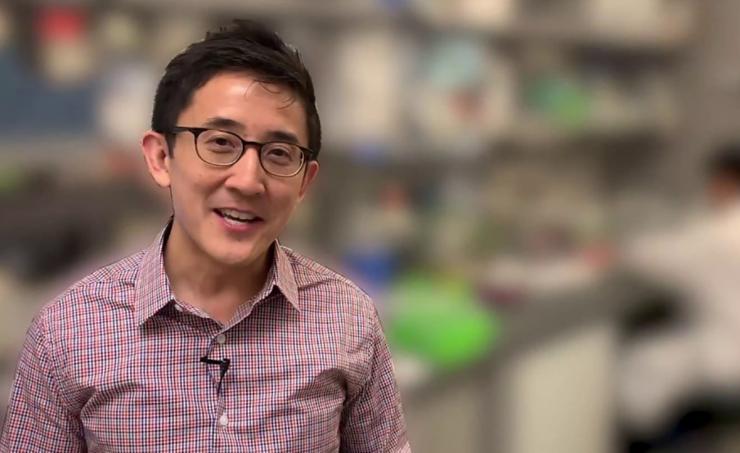Kwong Lab Develops Biosensors for Quick Assessment of Cancer Treatment
Mar 10, 2022 — Atlanta, GA

Gabe Kwong's lab has developed biosensors that can quickly assess a cancer treatment.
Immune checkpoint blockade (ICB) inhibitors have transformed the treatment of cancer and have become the frontline therapy for a broad range of malignancies. It’s because they work better than the previous standard of care.
Still, less than 25% of patients benefit from these drugs, which are designed to block proteins that stop the immune system from attacking cancer cells. And in many cases, that benefit is temporary. Compounding all of that is the difficulty in telling, in a timely fashion, if the treatment is working at all. That kind of critical feedback can determine whether a patient should stay the course or move onto an alternative therapy.
“We don’t have an effective way of providing that information early enough, and that’s a big problem,” noted Gabe Kwong, associate professor in the Wallace H. Coulter Department of Biomedical Engineering at Georgia Tech and Emory University. “Another problem is, even for patients that respond to the therapy, there will likely come a point when they develop a resistance and stop responding.”
So Kwong and his team have developed a system of synthetic biosensors that will let a patient and doctor quickly learn if an ICB therapy is working through a non-invasive urinalysis. The research team shared their work in a study published March 3 in the journal Nature Biomedical Engineering.
Typically, when physicians want to know if their patients are responding to cancer drugs, they have two basic options: They can perform a biopsy, but that is invasive, can be painful, and the results may take a few days. Or they can take pictures — a CT scan, for example — and actually look at the tumor. But imaging can be deceiving when monitoring immunotherapies. For example, if the tumor appears to have increased in size, it might seem like the drug isn’t working for the patient.
“But if you’re successful in activating the immune system, you’re going to get a flood of immune cells into the tumor, and it will look like the tumor has grown larger,” Kwong said. “In reality, the patient is responding to the therapy.”
That’s called “pseudoprogression” of the disease. In blocking the activity of those unfriendly proteins, the ICB drug activates protective T cells, which attack the tumor en masse. The T cells kill it with a deadly secretion of proteases called granzymes, part of the same class of enzymes found in the stomach that are used to digest food. Potent stuff.
“We reasoned, if patients are responding to the drug, it means these T cells are making proteases, and if they’re not responding, these proteases are not present, so the T cells are not active,” said Kwong, whose collaborators included Coulter Associate Professor Peng Qiu and lead authors Quoc D. Mac and Anirudh Sivakumar, both grad students when the study was conducted.
Kwong’s lab has been making and improving their synthetic biosensors for more than a decade. For this study, they developed sensors to detect both T cell and tumor proteases (tumors also secrete a type of protease) during ICB treatment.
The sensors are attached to the ICB drug that makes its way toward the tumor environment after injection. When they reach their destination, the sensors are activated by proteases produced by both T cells and tumor cells, which triggers the release of signaling fluorescent reporters that are designed to concentrate into urine.
“Basically, these signals would be diluted in blood and would be very hard to pick up, but everything from your blood gets filtered through the kidneys,” Kwong said. “So when we look at the urine, we get very concentrated signals, which increase or decrease, corresponding to whether the patients are responding or not.”
A second way of reading the biosensor reporters involves artificial intelligence and machine learning techniques to identify signal patterns that discriminate between the different ways the drug can fail. The second part of the paper focuses mainly on this, teasing apart two different mechanisms of intrinsic resistance.
“There are multiple versions of resistance,” Kwong said. “A patient can be intrinsically resistant to the therapy — that is, it would never work for them. And there are patients who have acquired resistance — the drug initially worked for them but over time it stops working.”
Kwong’s biosensors can tell if the drug is working and can discriminate between two mechanisms of intrinsic resistance — both due to mutations in different protein coding genes.
“Next we’d like to develop the same biosensor approach for patients that acquire resistance,” Kwong said. “We try to think of the patient journey in our work: the person who gets a bad diagnosis, starts a new treatment, responds to the drug, and then three months down the road they’re no longer responding. It’s a subtle difference, but a big problem.”
CITATION: Quoc D. Mac, Anirudh Sivakumar, Hathaichanok Phuengkham, Congmin Xu, James R. Bowen, Fang-Yi Su, Samuel Z. Stentz, Hyoungjun Sim, Adrian M. Harris, Tonia T. Li, Peng Qiu, Gabriel A. Kwong. “Urinary detection of early responses to checkpoint blockade and of resistance to it via protease-cleaved antibody-conjugated sensors.” Nature Biomaterials (March 3, 2022)
https://doi.org/10.1038/s41551-022-00852-y
FUNDING: This work was funded by the NIH Director’s New Innovator Award DP2HD091793 and National Cancer Institute R01 grant 5R01CA237210.
DISCLOSURES: Gabe Kwong is co-founder of and serves as consultant to Glympse Bio and Satellite Bio. This study could affect his personal financial status. The terms of this arrangement have been reviewed and approved by Georgia Tech in accordance with its conflict-of-interest policies. Mac, Bowen, and Kwong are listed as inventors on a patent application pertaining to the results of the paper. The patent applicant is the Georgia Tech Research Corporation. The application number is PCT/US2019/050530. The patent is currently pending/published (publication number WO2020055952A1). The mass-barcoded antibody-sensor conjugates and related applications are covered in this patent.





